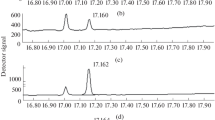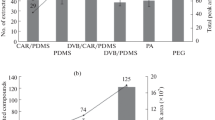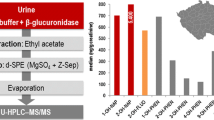Abstract
Marijuana abuse can be detected by means of toxicological analysis of the most important metabolite 11-nor-9-carboxy-Δ9-tetrahydrocannabinol (THC-COOH) in urine samples. The aim of this study is the establishment of the detailed procedure for analysis of THC-COOH in urine by combination of hollow fiber-liquid phase microextraction (HF-LPME) and gas chromatography–mass spectrometry (GC–MS). The conditions of hydrolysis and extraction were optimized. The method was shown to be very simple and rapid, and a low amount of organic solvent was necessary for extraction. The limit of detection was 1.5 ng/ml. The calibration curves were linear over the specified range (2.0–170 ng/ml; r 2 > 0.99). The main sources of uncertainty were found to be analyte concentration, accuracy, method precision and sample volume. The effect of the analyte concentration on the overall combined uncertainty was most significant. The developed method was successfully applied to a human urine standard reference material at two levels of concentration. The obtained relative combined uncertainty was 8 %, which can be considered acceptable according to international guidelines. The present method seems very useful in clinical and forensic toxicology, because of its simplicity, rapidness and inexpensiveness.




Similar content being viewed by others
References
Papoutsis I, Nikolaou P, Dona A, Pistos C, Stefanidou M, Spiliopoulou C, Athanaselis S (2012) A validated GC–MS method for the determination of Δ9-tetrahydrocannabinol and 11-nor-Δ9-tetrahydrocannabinol-9-carboxylic acid in bile samples. Forensic Toxicol 30:51–58
Fabritius M, Staub C, Mangin P, Giroud C (2013) Analysis of cannabinoids in oral fluid by liquid chromatography–tandem mass spectrometry. Forensic Toxicol 31:151–163
Namera A, Saito T, Miyazaki S, Ohta S, Oikawa H, Torikoshi A, Shiraishi H, Nagao M (2013) Sequential extraction of amphetamines, opiates, and 11-nor- Δ9-tetrahydrocannabinol-9-carboxylic acid from a limited volume of urine using a monolithic silica spin column coupled with gas chromatography–mass spectrometry. Forensic Toxicol 31:312–321
Kikura-Hanajiri R, Uchiyama N, Kawamura M, Goda Y (2013) Changes in the prevalence of synthetic cannabinoids and cathinone derivatives in Japan until early 2012. Forensic Toxicol 31:44–53
Scheidweiler KB, Desrosiers NA, Huestis MA (2012) Simultaneous quantification of free and glucuronidated cannabinoids in human urine by liquid chromatography tandem mass spectrometry. Clin Chim Acta 413:1839–1847
Felli M, Martello S, Chiarotti M (2011) LC–MS–MS method for simultaneous determination of THCCOOH and THCCOOH-glucuronide in urine: application to workplace confirmation tests. Forensic Sci Int 204:67–73
Lacroix C, Saussereau E (2012) Fast liquid chromatography/tandem mass spectrometry determination of cannabinoids in micro volume blood samples after dabsyl derivatization. J Chromatogr B 905:85–95
Stephanson N, Josefsson M, Kronstrand R, Beck O (2008) Accurate identification and quantification of 11-nor-Δ9-tetrahydrocannabinol-9-carboxylic acid in urine drug testing: evaluation of a direct high efficiency liquid chromatographic–mass spectrometric method. J Chromatogr B 871:101–108
Racamonde KE, Villaverde-de-Sáa E, Rodil R, Quintana JB, Cela R (2012) Determination of Δ9-tetrahydrocannabinol and 11-nor-9-carboxy-Δ9-tetrahydrocannabinol in water samples by solid-phase microextraction with on-fiber derivatization and gas chromatography-mass spectrometry. J Chromatogr A 1245:167–174
De Brabanter N, Gansbeke WV, Hooghe F, Van Eenoo P (2013) Fast quantification of 11-nor-Δ9-tetrahydrocannabinol-9-carboxylic acid (THCA) using microwave-accelerated derivatisation and gas chromatography–triple quadrupole mass spectrometry. Forensic Sci Int 224:90–95
Jagerdeo E, Montgomery MA, Karas RP, Sibum M (2010) A fast method for screening and/or quantitation of tetrahydrocannabinol and metabolites in urine by automated SPE/LC/MS/MS. Anal Bional Chem 398:329–338
NIDA (2014) http://www.drugabuse.gov/ Accessed 02 February 2014
Zanchetti G, Floris I, Piccinotti A, Tameni S, Polettini A (2012) Rapid and robust confirmation and quantification of 11-nor-Δ9-tetrahydrocannabinol-9-carboxylic acid (THC-COOH) in urine by column switching LC-MS-MS analysis. J Mass Spectrom 47:124–130
Chebbah C, Pozo OJ, Deventer K, Eenoo PV, Delbeke FT (2010) Direct quantification of 11-nor-Δ9-tetrahydrocannabinol-9-carboxylic acid in urine by liquid chromatography/tandem mass spectrometry in relation to doping control analysis. Rapid Commun Mass Spectrom 24:1133–1141
Fernández MMR, Wille SMR, Samyn N, Wood M, Lopes-Rivadulla M, De Boeck G (2009) On-line solid-phase extraction combined with chromatography-tandem mass spectrometry for high throughput analysis of 11-nor-9-carboxy-Δ9-tetrahydrocannabinol acid in urine. J Chromatogr B 877:2153–2157
Robandt PV, Klette KL, Sibum M (2009) Automated solid-phase extraction-liquid chromatography-tandem mass spectrometry analysis of 11-nor-Δ9-tetrahydrocannabinol-9-carboxylic acid in human urine specimens: application to a high-throughput urine analysis laboratory. J Anal Toxicol 33:456–460
Chericoni S, Battistini I, Dugheri S, Pacenti M, Giusiani M (2011) Novel method for simultaneous aqueous in situ derivatization of THC and THC-COOH in human urine samples: validation and application to real samples. J Anal Toxicol 35:193–198
Fu S, Lewis J (2008) Novel automated extraction method for quantitative analysis of urinary 11-nor-Δ9-tetrahydrocannabinol-9-carboxylic acid (THC-COOH). J Anal Toxicol 32:292–297
Abraham TT, Lowe RH, Pirnay SO, Darwin WD, Huestis MA (2007) Determination of Δ9-tetrahydrocannabinol, 1-hydroxy-Δ9-tetrahydrocannabinol, and 11-nor-9-carboxy-Δ9-tetrahydrocannabinol in human urine following tandem enzyme-alkaline hydrolysis. J Anal Toxicol 31:477–485
Kumazawa T, Hasegawa C, Lee X-P, Sato K (2010) New and unique methods of solid-phase extraction for use before instrumental analysis of xenobiotics in human specimens. Forensic Toxicol 28:61–68
Pantaleão LN, Paranhos BAPB, Yonamine M (2007) Hollow-fiber liquid-phase microextraction of amphetamine-type stimulants in human hair samples. J Chromatogr A 1254:1–7
Barroso M, Moreno I, Fonseca B, Queiroz JA, Gallardo E (2012) Role of microextraction sampling procedures in forensic toxicology. Bioanalysis 4:1805–1826
Menck RA, de Oliveira CDR, de Lima DS, Goes LE, Leyton V, Pasqualucci CA, Muñoz DR, Yonamine M (2013) Hollow fiber–liquid phase microextraction of barbiturates in liver samples. Forensic Toxicol 31:31–36
dos Santos MF, Ferri CC, Seulin SC, Leyton V, Pasqualucci CAG, Muñoz DR, Yonamine M (2014) Determination of antidepressants in whole blood using hollow-fiber liquid-phase microextraction and gas chromatography-mass spectrometry. Forensic Toxicol. doi:10.1007/s11419-014-0226-9
Lee J, Lee H, Rasmussen K, Pedersen-Bjergaard S (2008) Environmental and bioanalytical applications of hollow fiber membrane liquid-phase microextraction: a review. Anal Chim Acta 624:253–268
Gullberg RG (2012) Estimating the measurement uncertainty in forensic blood alcohol analysis. J Anal Toxicol 36:153–161
Sklerov JH, Couper FJ (2011) Calculation and verification of blood ethanol measurement uncertainty for headspace gas chromatography. J Anal Toxicol 35:402–410
Lee S, Choi H, Kim E, Choi H, Chung H, Chung KH (2010) Estimation of the measurement uncertainty by the bottom-up approach for the determination of methamphetamine and amphetamine in urine. J Anal Toxicol 34:222–228
EURACHEM/CITAC (2000) Quantifying uncertainty in analytical measurement, 3rd edn. Laboratory of the Government Chemist, London. http://www.pg.gda.pl/chem/Dydaktyka/Analityczna/STAT/Quantyfying%20uncertainity%20in%20analytical%20measurement.pdf. Accessed 10 Jan 2014
UNODC (2009) Guidance for the validation of analytical methodology and calibration of equipment used for testing of illicit drugs in seized material and biological specimens. Laboratory and Scientific Section, United Nations Office on Drugs and Crime, Vienna. http://www.unodc.org/documents/scientific/validation_E.pdf. Accessed 02 May 2014
Peters FT, Maurer HH (2002) Bioanalytical method validation and its implications for forensic and clinical toxicology—a review. Accred Qual Assur 7:441–449
Peters FT, Drummer OH, Musshoff F (2007) Validation of new methods. Forensic Sci Int 165:216–224
SWGTOX (2013) Standard practices for method validation in forensic toxicology. Revision 1. http://www.swgtox.org/documents/Validation3.pdf. Accessed 02 May 2014
GUM (1995) International organization for standardization. http://www.bipm.org/utils/common/documents/jcgm/JCGM_100_2008_E.pdf. Accessed 10 January 2014
Moon J, Kim JY, Moon MH, Chung BC, In MK, Choi MH (2008) Validated gas chromatographic–mass spectrometric analysis of urinary cannabinoids purified with a calcium-hardened cyclodextrin polymer. J Chromatogr A 1204:87–92
Weinmann W, Goerner M, Vogt S, Goerke R, Pollak S (2001) Fast confirmation of 11-nor-9-carboxy-Δ9-tetrahydrocannabinol (THC-COOH) in urine by LC/MS/MS using negative atmospheric-pressure chemical ionisation (APCI). Forensic Sci Int 121:103–107
Kim SY, Kim JY, Kwon W, In MK, Kim YE, Paeng K (2013) Method development for simultaneous determination of amphetamine type stimulants and cannabinoids in urine using GC–MS. Microchem J 110:326–333
Kramer KE, Andrews ARJ (2001) Screening method for 11-nor-Δ9-tetrahydrocannabinol-9-carboxylic acid in urine using hollow fiber membrane solvent microextraction with in-tube derivatization. J Chromatogr B 760:27–36
Moffat AC, Osselton MD, Widdop B, Watts J (2011) Clarke’s analysis of drugs and poisons. Pharmaceutical Press, London
Pedersen-Bjergaard S, Rasmussen KE (2008) Liquid-phase microextraction with porous hollow fibers, a miniaturized and highly flexible format for liquid–liquid extraction. J Chromatogr A 1184:132–142
WADA (2010) Technical document TD2010DL. Decision limits for the confirmatory quantification of threshold substances.http://www.wada-ama.org/Documents/World_Anti-Doping_Program/WADP-IS-laboratories/Technical_Documents/WADA-TD2010DL-1.0-Decision-Limits-for-Confirmatory-Quantification-of-Threshold-Substances-EN.pdf. Accessed 02 May 2014
Acknowledgments
The authors acknowledge financial support from Conselho Nacional de Desenvolvimento Científico e Tecnológico (CNPq grants no 470829/2012-5, Brazil). The authors also thank Tiago Franco de Oliveira, PhD who prepared the figures.
Conflict of interest
There are no financial or other relations that could lead to a conflict of interest.
Author information
Authors and Affiliations
Corresponding author
Rights and permissions
About this article
Cite this article
de Souza Eller, S.C.W., Flaiban, L.G., Paranhos, B.A.P.B. et al. Analysis of 11-nor-9-carboxy-Δ9-tetrahydrocannabinol in urine samples by hollow fiber-liquid phase microextraction and gas chromatography–mass spectrometry in consideration of measurement uncertainty. Forensic Toxicol 32, 282–291 (2014). https://doi.org/10.1007/s11419-014-0239-4
Received:
Accepted:
Published:
Issue Date:
DOI: https://doi.org/10.1007/s11419-014-0239-4




